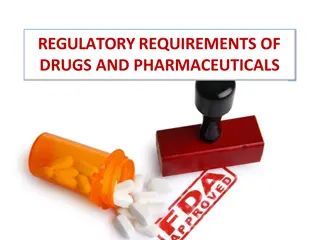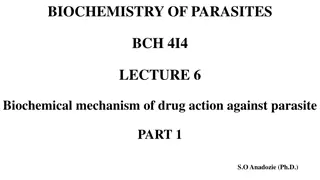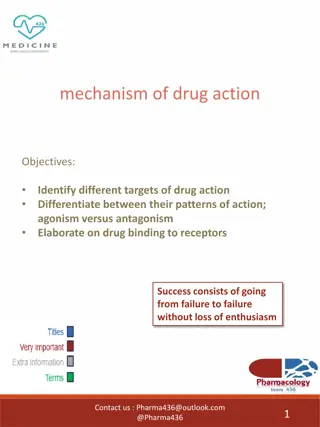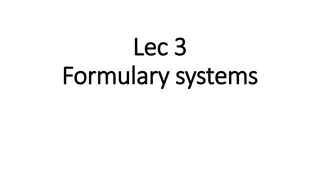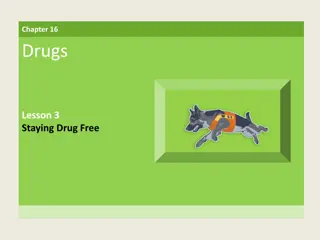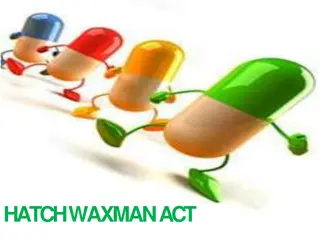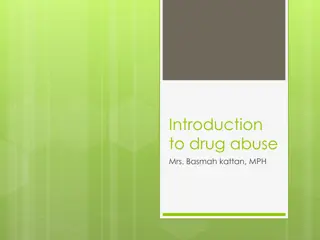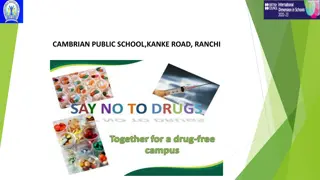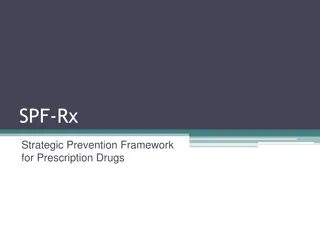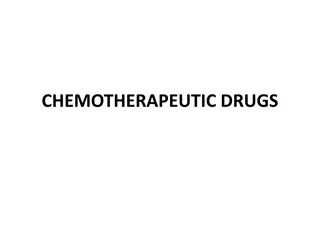Understanding Drug Targets and Mechanisms of Action
Explore the intricate world of pharmacokinetics and pharmacodynamics, from drug absorption to their interaction with biological molecules. Learn about different drug targets, such as proteins and ions, and how drugs alter their biochemical and biophysical activities. Dive into molecular mechanisms of drug action, including how drugs bind to receptors and compete with natural substrates for enzymes. Gain insights into the regulatory and structural roles of proteins in drug interactions, and understand how various drugs target specific molecules to elicit therapeutic responses.
Download Presentation

Please find below an Image/Link to download the presentation.
The content on the website is provided AS IS for your information and personal use only. It may not be sold, licensed, or shared on other websites without obtaining consent from the author. Download presentation by click this link. If you encounter any issues during the download, it is possible that the publisher has removed the file from their server.
E N D
Presentation Transcript
PHARMACOKINETICS Absorb Distribute Metabolize Excrete Osmotic Diuretics Purgatives Antacids Exceptions Interacts with biological molecules TARGETS altering their biochemical &/or biophysical activity Depress Activate Replace Irritate Destroy RESPONSE PHARMACODYNAMICS
ilos By the end of this lecture you will be able to : Identify different targets of drug action Differentiate between their patterns of action; agonism versus antagonism Elaborate on drug binding to receptors MOLECULAR MECHANISMS OF DRUG ACTION
TARGETS > Proteins REGULATORY STRUCTURAL Tubulinis target for: Vincristine CARRIER MOLECULE ION RECEPTOR ENZYME Colchicine CHANNEL Tubulin Structure
TARGETS Proteins REGULATORY The drug competes with the natural substrate for the enzyme ENZYME REVERSIBLE REVERSIBLE Neostigmine reversibly compete with ACH for cholinestrase IRREVERSIBLE IRREVERSIBLE Organophosphates irreversibly competes with ACH for cholinestrase Neostigmine Organophosphorsphates
TARGETS Proteins REGULATORY MAO_cocaine Responsible for transport of ions and small organic molecules between intracellular compartments, through cell membranes or in extracellular fluids. CARRIER MOLECULE The drug binds to such molecules altering their transport ability Cocaine blocks transport of catecholamines at synaptic cleft Antiporter Symporter
TARGETS > Proteins REGULATORY CARRIER MOLECULE Digitalis blocks efflux of Na by Na pump Digitalis
TARGETS > Proteins REGULATORY ION Responsible for influx or out-flux of ions through cell membranes along their concentration gradients. They are activated by alteration in action potential and are controlled by gating machinery. Local Anesthetics block Na influx through Na channel in nerve fibers. They are Na channel Blockers. Drugs bind to alter channel function by block or modulation CHANNEL L.Anaesthesia
TARGETS > Proteins REGULATORY ION CHANNEL Sulfonylurea drugs block K+out flux via the K channels in pancreatic cells . They are K Channel Modulator
TARGETS > Proteins REGULATORY Responsible for selectively sensing and binding of a Drugs bind and alter R signal transduction machinery. stimulus (ligand) and its coupling to a response via a set of signal transduction machinery Bind Occupy RECEPTOR Initiate Activate Physiological RESPONSE L L LR* R EFFICACY AFFINITY ENDOGENOUS LIGAND Pharmacological RESPONSE R A drug that possesses both affinity and efficacy Agonist A A R AR* ACh DRUGS A drug that possesses an affinity but no efficacy Antagonist Tubocurarine NO RESPONSE B B R
The tendency of a drug to bind to the receptors is governed by its affinity. AFFINITY The ability for it, once bound, to activate the receptor is denoted by its efficacy. EFFICACY Agonist A drug that possesses both affinity and efficacy Is that inherent property intrinsic to the agonist that determines how "good" an agonist is. high intrinsic efficacy a full agonist low intrinsic efficacy a partial agonist. Antagonist A drug that possesses an affinity but no efficacy
Ligand Agonist Ligand High intrinsic efficacy low intrinsic efficacy Submax response agonist. Max response Agonistic-Antagonistic Potentials A Full Agonist A Partial Agonist Pindolol, a beta blocker which is a partial agonist, produces less decrease in heart rate than pure antagonists such as propranolol.
The tendency of a drug to bind to the receptors is governed by its affinity. AFFINITY The ability for it, once bound, to activate the receptor is denoted by its efficacy. EFFICACY QUANTIFY ASPECTS OF DRUG ACTION Initiate Activate Bind Occupy D + R D R RESPONSE[R] DR* Relate concentration [C] of D used (x- axis) to the binding capacity at receptors (y-axis) Relate concentration [C] of D used (x- axis) to the R produced (y-axis) Concentration-Binding Curve Dose Response Curve AFFINITY EFFICACY POTENCY
Concentration-Binding Curve Initiate Activate Bind Occupy association rate constant k1 D + R D R RESPONSE[R] DR* k2 dissociation rate constant At equilibrium the equilibrium dissociation constant (KD) is presented by ratio (k2/k1) The relationship between drug binding & drug concentration is expressed mathematically by the following equation Bmax xC B = ----------- C+ KD50
Concentration-Binding Curve (Bmax): Total density of receptors in the tissue KD KD (kD ) = [C] of D required to occupy 50% of receptors at equilibrium Concentration-Binding curves are used to determine: 1. The binding capacity (Bmax) total density of receptors in the tissues. 2. The affinity of D for receptor The higher the affinity of D for receptor the lower is the KD i.e. inverse relation
DOSE RESPONSE CURVE How does response vary with C? See full size image A continuous response BP, HR, FBG, Cholesterol, GRADED DOSE RESPONSE CURVE An all-or-non response prevention of convulsion, arrhythmias or death .. Relate C to % of patients eliciting the : * specified therapeutic response * adverse response * lethal outcome QUANTAL DOSE RESPONSE CURVE How the therapeutic window of a drug is defined ?
L L G G U U O O C C O O K K D D


